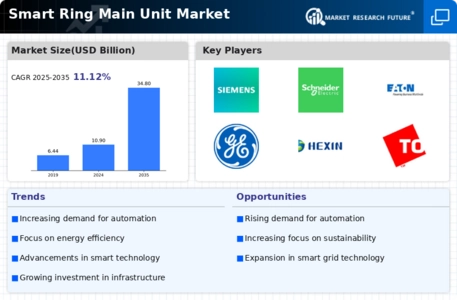Regulatory Frameworks
The Smart Ring Main Unit Market is influenced by evolving regulatory frameworks aimed at promoting energy efficiency and sustainability. Governments are increasingly implementing policies that encourage the adoption of smart technologies in energy distribution. These regulations often include incentives for utilities to upgrade their infrastructure, which can lead to increased investments in smart ring main units. For instance, mandates for reducing carbon emissions and enhancing grid resilience are pushing utilities to adopt more advanced solutions. As these regulatory pressures mount, the Smart Ring Main Unit Market is likely to see a rise in demand, as companies seek to comply with new standards while improving their operational capabilities.
Increased Energy Demand
The Smart Ring Main Unit Market is also driven by the rising global energy demand. As populations grow and economies develop, the need for reliable and efficient energy distribution systems becomes paramount. Smart ring main units play a crucial role in managing this demand by providing enhanced load management and fault detection capabilities. The International Energy Agency has reported a steady increase in electricity consumption, which underscores the necessity for modernized infrastructure. This growing energy demand is likely to propel investments in smart ring main units, as they offer solutions that can accommodate higher loads while ensuring system reliability. Consequently, the Smart Ring Main Unit Market stands to benefit from this upward trend.
Technological Integration
The Smart Ring Main Unit Market is experiencing a surge in demand due to the rapid integration of advanced technologies. Innovations such as IoT connectivity and smart grid solutions are enhancing the functionality of ring main units. These technologies allow for real-time monitoring and control, which improves operational efficiency and reduces downtime. As utilities and industries seek to modernize their infrastructure, the adoption of smart ring main units is likely to increase. According to recent estimates, the market for smart grid technologies is projected to grow significantly, indicating a favorable environment for the Smart Ring Main Unit Market. This trend suggests that companies investing in technological advancements may gain a competitive edge.
Sustainability Initiatives
The Smart Ring Main Unit Market is benefiting from a heightened focus on sustainability initiatives across various sectors. As organizations strive to reduce their carbon footprint, the demand for energy-efficient solutions is on the rise. Smart ring main units contribute to this goal by optimizing energy distribution and minimizing losses. The transition towards renewable energy sources also necessitates the integration of smart technologies to manage variable loads effectively. Reports indicate that investments in sustainable energy solutions are increasing, which bodes well for the Smart Ring Main Unit Market. This alignment with sustainability goals is likely to attract further investments and innovations in smart ring main units.
Focus on Reliability and Safety
The Smart Ring Main Unit Market is significantly driven by the growing emphasis on reliability and safety in electrical distribution systems. As the frequency of power outages and electrical failures can have severe consequences, utilities are prioritizing the implementation of technologies that enhance system resilience. Smart ring main units offer features such as automated fault detection and isolation, which contribute to improved safety and reliability. The increasing awareness of the importance of maintaining uninterrupted power supply is likely to drive investments in these advanced units. Consequently, the Smart Ring Main Unit Market is positioned to grow as stakeholders recognize the value of reliable energy distribution solutions.

















Leave a Comment